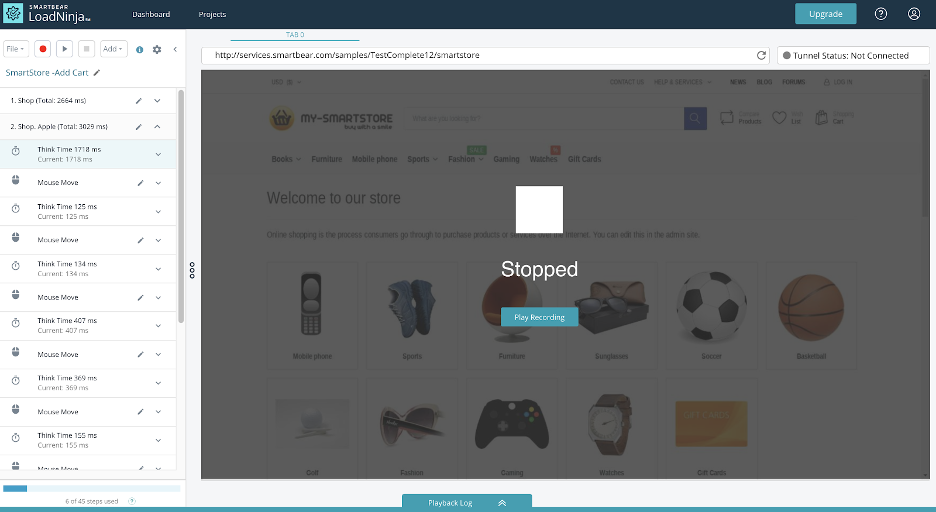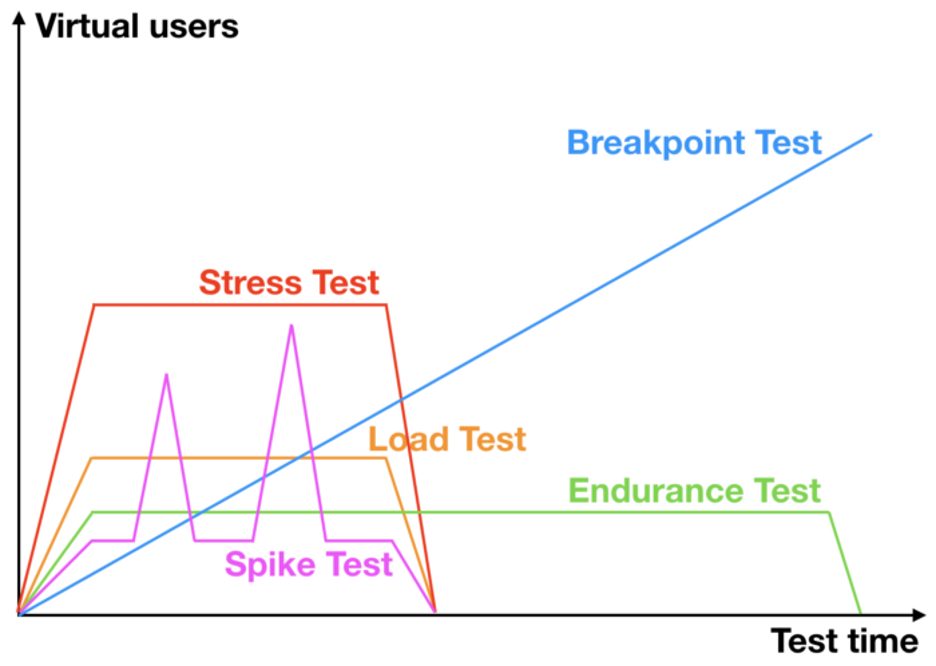Performance tests assess how an application performs under a given load. Unlike functional tests, they compare performance to benchmarks rather than identify defects. Although the results can be helpful for diagnosing bottlenecks. Performance tests are essential for ensuring a high-quality user experience and meeting performance requirements.
For example, suppose you operate an ecommerce application, and want to ensure it handles Black Friday traffic without a costly slowdown. You could use a spike test to simulate above-average levels of traffic. This will determine if the application experiences a slowdown, and where the slowdown occurs.
There are two types of performance tests:
- Protocol-based tests simulate traffic via HTTP protocols and measure the response time. For example, a test might make an HTTP GET request and measure how long it takes the server to respond to the request with a payload.
- Browser-based tests spin up actual web browsers that make requests as a real user would, so it assesses both the time it takes for a response, and the time it takes the browser to fully render the response.

The Easy-to-Use Interface on LoadNinja – Source: LoadNinja
Most performance testing tools run protocol-based test scripts that must be written by an experienced test engineer. LoadNinja simplifies the process with an easy-to-use, record-and-replay, browser-based test recorder. And it has the ability to scale tests across tens of thousands of actual browser instances for the most accurate results.
In addition to its ease of use, LoadNinja provides helpful tools to diagnose bottlenecks. Test engineers can instantly identify potential issues with a machine-learning powered assistant that looks for abnormalities, while developers can dive into virtual browser sessions and navigate the DOM to pinpoint bottlenecks in a fraction of the time.
There are a lot. While they all simulate traffic, they have different goals, and send varying levels of traffic at varying capacities. Some tests are designed to assess a baseline performance, while others are good for testing edge cases on an ad-hoc basis.
There are four common types of performance tests designed to assess applications:
- Load Tests: Measure performance as a workload increases to expected production levels. The goal is to ensure that any updates to an application continue to meet minimum performance standards.
- Stress Tests: Measure performance outside of typical production levels to measure when and how it fails. The goal is to identify the breaking points of an application and potentially fix bottlenecks.
- Spike Tests: Measure performance when a workload suddenly and substantially increases beyond typical production levels. The goal is to see how an application would perform if traffic suddenly spiked in production.
- Endurance Tests: Aka soak tests, measure performance at a normal workload over an extended period of time. The goal is to expand upon load tests by determining if a long-running task causes issues over time.
There are also a couple of tests designed to assess infrastructure:
- Scalability Tests: Similar to load tests, except they look at CPU usage, memory, and other infrastructure rather than the application. The goal is typically to determine how costly it would be to scale up infrastructure.
- Volume Tests: Similar to stress tests, except they focus on large amounts of data hitting databases and data-processing tasks. The goal is to determine if database access eventually becomes a bottleneck.
What’s the Right One for You?
The most effective type of performance test depends on the objective. Using the same example as above, an ecommerce application should use a spike test to assess application performance ahead of Black Friday rather than a load test or endurance test.

Types of Performance Tests – Source: Team Merlin
The most common use cases for each performance test type include:
- Load Test: Ideal for ensuring consistent performance under an expected load. These tests should run on a regular basis with each major deployment, typically as part of a continuous integration and deployment process.
- Stress Test: Ideal for understanding the limits of an application and should be run periodically to identify weak points. These tests are typically run ad hoc when there is a major code change that could impact application performance.
- Spike Test: Ideal for testing ahead of a major holiday or event, such as a sale or marketing campaign, to ensure that the application can handle a sudden influx of traffic.
- Endurance Test: Ideal for testing following a new release to ensure that it holds up over time. These tests are helpful if there are new processing tasks that could impact performance over time and are typically run ad hoc.
- Infrastructure Test: Ideal for testing every now and then to ensure that infrastructure costs remain under control and databases aren’t prone to failure.
Many load testing tools support different performance test types along with both CI/CD and ad-hoc capabilities. For instance, LoadNinja makes it easy to run all of these performance test types and includes built-in integrations with Jenkins CI to make it easy to run load tests on a continuous basis to ensure performance before each major deployment.
The Bottom Line
Performance tests are a critical part of modern software development. By choosing the right performance test for the job, you can ensure that applications meet minimum standards and deliver the best possible user experience. These tests should be incorporated into a wider testing strategy to ensure the highest quality software with each release.
If you’re looking for an easy way to develop powerful performance tests, LoadNinja’s browser-based record-and-replay platform may be the answer.